Cutworms
Asparagus Beetles
Oedema
Flea Beetles in Brassicas
Potato Seed Problems
 |
| Cutworms around a broccoli seedling |
CUTWORMS (many species)
Cutworms are occasional pests of many crops early in the season, including carrots, peas, onions, spinach, broccoli and the list goes on and on. Some years they result in major losses, other years result in no loss at all. This year I am finding large cutworms already that must be from a fall flight. They are larvae of a dozen or so different species of night flying moths. They are greasy looking caterpillars that have a habit of curling into a “C” shape when disturbed. Many species that attack vegetables overwinter as partially grown larvae and so can become active very early in the spring when the plants first germinate and are very susceptible. Others arise from moths that fly in early in the spring, and these feed well into the early summer. Cutworms hide in the soil during the day and crawl on the surface at night. They feed and cut off young seedlings at the soil surface, or climb up and chew on the leaves. During the day, you can dig around an inch or two deep around damaged plants and often find the ugly critter. Chickens love them.
Cultural Control
Since most species lay their eggs in the late summer/fall on vegetation, keeping fields clean of weeds and crops in the fall helps. Of course, this goes counter to the recommendations to keep the soil covered cropped, so it is a management decision based on how bad the problem has been. Fall plowing exposes larvae to birds. Cultivating fields in the spring just after vegetation has appeared and grown a few inches, and keeping it clean cultivated can starve the cutworms out before the peas go in. But, in must areas this is not practical because crops need to be planted.
On a small scale, collars built around each plant will keep the caterpillar away. Going out at night with a flash light and hand picking breakfast for your chickens can work.
Materials Approved for Organic Production
Entomopathogenic nematodes show good efficacy when environmental conditions are favorable. Steinernema carpocapsae has been shown to be very effective against cutworms. Success with nematodes depends on proper application methods. Be sure to follow the instructions from the supplier carefully. A few suppliers of these insect-attacking nematodes are IPM Laboratories (www.ipmlabs.com), and ARBICO (www.arbico.com).
Baits – Spinosad or Bt will kill the caterpillars, but getting the pest to consume the insecticide as a sprayed on material before significant damage is done is not likely. However, farmers and gardeners have reported good results using these materials in baits. The bait is spread on the ground near the plants, or prior to planting to clean out an area.
Spinosad – Seduce (OMRI Listed) is a commercial bait.
Bt – A bait made from Bt is often recommended and has received good reports from farmers. This is a method of use of Bt that is not described on the label. This off-label use is permitted by EPA under FIFRA 2ee, but growers should check with their state pesticide regulators about their state regulations. Make the bait by mixing the highest concentration solution of Bt allowed on the label and then mixing in a bit of molasses and alfalfa meal or bran. Then dampen this mix if necessary. Spread the bait along the planted or planned rows in the evening.
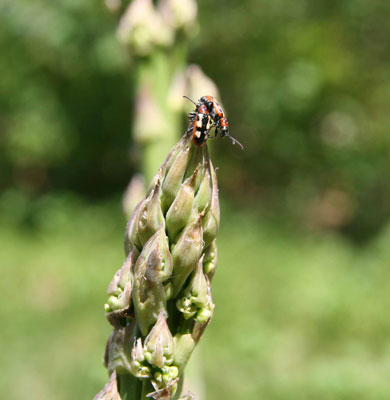 |
| Common asparagus beetles |
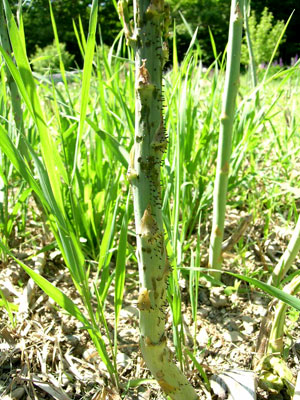 |
| Common asparagus beetle eggs on an asparagus spear |
ASPARAGUS BEETLE, COMMON AND SPOTTED
Frost First
One of the very first questions I received when I began working for MOFGA many, many years ago turned into an argument. Not a good start for my tenure, but I stuck it out. The guy who called would not believe me that asparagus is frost sensitive. His spears had turned dark, wrinkled and water-soaked. I don’t know if I ever convinced him that the problem was they were frosted. Perhaps he is reading this.
Asparagus, despite its status as a primo early season vegetable, is highly sensitive to frost, ranking alongside cucumber, snap beans, eggplant and tomatoes in the ‘most susceptible’ category. There is still a chance of frost.
When frosted, spears appear slightly darker green, water-soaked and break off easily. Thawed spears become mushy. Soft-rotting bacteria can enter the damaged tissue. New spears take several more days to emerge, but will. Temperatures below 33 degrees Fahrenheit may damage the spears.
The Beetles
I have seen both kinds of asparagus beetles here already. Usually the spotted asparagus beetle becomes active somewhat later in the spring, and in my experience is less common (I guess with the names that is not a surprise). These two beetles are closely related and have similar life cycles, but it is the common asparagus beetle that is most damaging to the spears.
Common asparagus beetle (Crioceris asparigi) is blue-black, shiny, smooth and about 6 to 9 mm (1/4 inch) long, with three large yellow, squarish spots with red margins along each wing cover. Eggs are black, laid standing on end in rows along the spears, and hatch in 3-8 days. [Remember, you can see pictures on the MOFGA web version of the Pest Report]. Larvae are wrinkled, plump, hump-backed, and dull gray with black head and legs. Some people call them “worms”. They grow up to 1/3 inch. These larvae feed in spears and in ferns. The larvae do the most damage, and eggs and larval damage makes spears unmarketable. Larval feeding can cause severe defoliation and weaken the stand. When full grown, larvae drop to the soil and pupate underground. New adults emerge in July, feed in ferns, and by September are looking for overwintering sites. Both species spend the winter as adult beetles either in field borders or within the asparagus field. Sheltered sites such as under bark or in the stems of old plants are preferred. Some burrow into the soil.
Spotted asparagus beetle (Crioceris duodecimpunctata) is reddish orange or tan, with six black spots on each wing cover (hence its other name, 12-spotted asparagus beetle). Eggs are greenish, glued singly on their sides to leaves. Eggs are laid on fronds, not on spears. Larvae are similar to those described above, but are orange colored, and feed almost entirely inside the berries so they affect seed production but do not hurt the plants.
Cultural controls: During harvest, you can greatly reduce the population by harvesting ALL of the ready spears every harvest. Do not allow any spears to develop into fronds until you are all done harvesting for the season. This reduces the number of stems where eggs will survive, and larvae can feed and grow up into the summer-generation beetles.
In the fall remove all of the crop residue and other refuse nearby that provides shelter for adults over winter. Maintaining a clean environment in the fall will force beetles to seek shelter outside the field or burrow in the soil, where many predators reside.
Biocontrol: The most important natural enemy of common asparagus beetle is a tiny parasitic wasp (Tetrastichus asparagi) that attacks the egg stage. Wasps kill eggs by feeding on them (sucking them dry), and also lay their own eggs inside the beetle eggs. The immature wasps grow inside the beetle larvae, killing them when they pupate. Studies have found >50% of eggs killed by feeding and half of the surviving larvae parasitized. Providing a nearby nectar source such as umbelliferous flowers may enhance wasp populations.
Monitoring and chemical control: Scout fields regularly. You may want to treat spears if >10% of the plants are infested with beetles. The daily harvest makes treatment difficult because few want to spray anything close to harvest time. Treating infested fronds is important. Organic options include Entrust. Surround WP may work as a repellent.
Thanks to: Ruth Hazzard (U. Mass Vegetable Notes & The New England Vegetable Management Guide), and Brian Caldwell, Cornell University
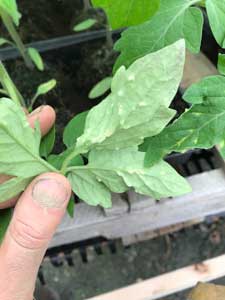 |
| Oedema on tomato |
OEDEMA (EDEMA)
I often get calls this time of year from folks who fear they have a disease on their tomatoes, or related crops such as tomatillo. It is also a common problem in plants in the cabbage family, and some house plants. They see blisters or bumps on the surface of the leaves, most often the underside. The swellings initially appear pale-green, but they can erupt and turn yellow, brown or even black. Eventually, corky spots appear on the underside of the leaves. Older leaves are more often affected than younger leaves.
Oedema is not a disease caused by a pathogen, but rather is a physiological disorder that develops when a plant absorbs water faster than it can be lost from the leaf surface. Excess moisture builds and the blisters form. This is most commonly induced when transpiration is limited. Transpiration (the natural loss of water from the plant) is reduced by cloudy days, humid conditions in a greenhouse, cool temperatures, low light levels such as when plants are raised on a windowsill in a home, etc. Overwatering under these conditions is commonly the biggest factor causing the problem.
Leaves affected with edema never clear up, but there are steps to be taken to prevent more of the problem:
* Cut back on watering when conditions favor edema, but, of course, do not let the plants completely dry out.
* Water only in the morning
* Increase the light if it is low.
* Increase ventilation and avoid over-crowding plants
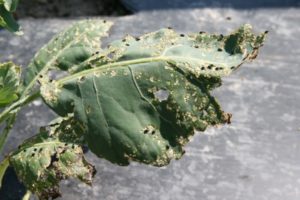 |
| Flea beetles on broccoli leaf. |
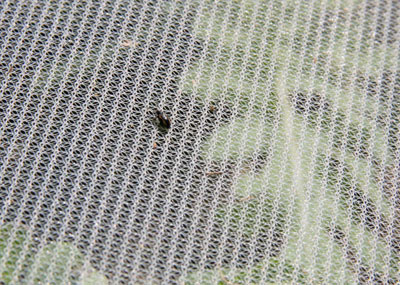 |
| Flea beetle trying to get through Proteknet. (www.duboisag.com/en/proteknet-insect-netting.html) |
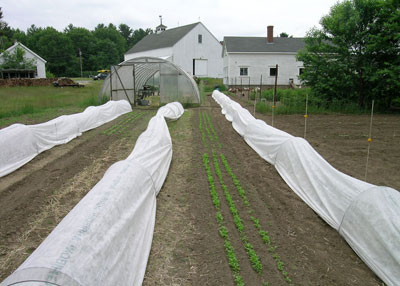 |
| Row covers |
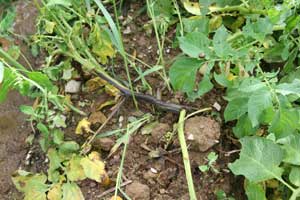 |
| Dicheya blackleg on potato |
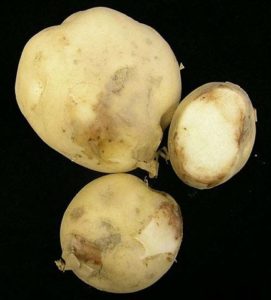 |
| Late blight on potato tubers |
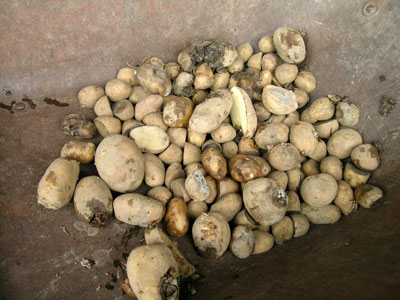 |
| Fusarium dry rot on potatoes |
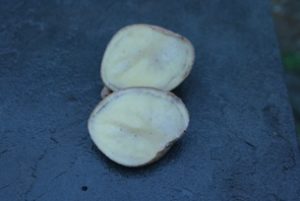 |
| Ring rot on potato |
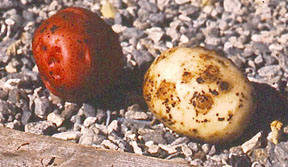 |
| Black scurf on potatoes |
FLEA BEETLES IN BRASSICAS
Flea beetles are busy feeding in spring plantings of brassica crops in Massachusetts. Numbers are likely to rise in coming weeks here in Maine as beetles move out of field borders where they spent the winter. Crucifer and striped flea beetles feed on Brassica crops as well as weeds that are in the same family, such as yellow rocket or wild mustard. [It is a different species of flea beetles that feeds on the tomato family of crops. This is important information when planning rotations of potatoes or tomatoes with Brassica cash or cover crops].
The crucifer flea beetle (Phyllotreta cruciferae) is uniformly black and shiny, about 2 mm in length, while the striped flea beetle (Phyllotreta striolata) has two yellow stripes on its back. Flea beetle adults feed on leaves and stems, resulting in numerous small holes, or ‘shot-holes.’ Eggs are laid in the soil starting in late May, and beetle larvae feed on roots. The non-waxy greens (arugula, bok choi, tatsoi, mustard, Chinese cabbage, komatsuna) are preferred to the waxy cabbage, kale and collard types of brassicas. In brassica greens, beetles feed on the whole surface of the leaf, and will continue feeding from the seedling stage until harvest. Waxy crops are most susceptible at the cotyledon and seedling stage and feeding is more limited to leaf margins on older plants. Some crops simply out grow the beetle pressure and the damage can be tolerated. No damage can be tolerated in crops such as arugula.
To reduce and delay flea beetle invasion of spring crops, move them as far away as possible from the fields that were used for Brassica crops last fall. Beetles overwinter in field borders near last year’s crop. Planting the same crop close by to where it was last year ensures a high population in the spring. The same could be true if you have fields full of mustard weeds.
One of the best ways to protect Brassica crops from flea beetles is to place a floating row cover over the bed or row. It is critical to seal the edges immediately after seeding or transplanting, because Brassica seeds germinate quickly and beetles rapidly find the cotyledons. Flea beetles can fit through extremely tiny cracks. Edges of the cover must be sealed on all sides using soil, plastic bags filled with soil, or some other method.
Spinosad (Entrust is organic formulation) is proving to be effective in suppressing flea beetles and reducing damage. Pyrethrin (Pyganic EC 5) showed poor to moderate efficacy in trials, and has a short residual period. Yet some growers have reported a good knockdown with this product. You can spray right through the floating row covers and knock down any flea beetles that may have gotten inside.
POTATO PLANTING TIME: DON’T PLANT A PROBLEM
Potato seed tubers are often the source of infection for your crop, and so inspection before planting is well worth the time. Some problem seed pieces are not going to spread a disease and can be planted. Others should never be planted. Here are some common issues.
Dickeya is a new disease in the USA, a type of blackleg. It is caused by a bacterium (Dickeya dianthicola). It is spread by planting contaminated seed. The disease does not survive in the soil long, and so the major way it spreads is by seed. Be sure to buy certified seed, although it seems that there is not yet a sure fire test. For the whole story, see https://vegetablemdonline.ppath.cornell.edu/NewsArticles/Potato-Dickeya.html
Late Blight – Look at the picture on this Pest Report if you don’t know what this looks like. If you are not sure, check with an expert. Besides taking down your potato crop, planting potato seed carrying late blight is the most likely source of a community or state wide problem . Do not plant any potatoes suspected of being infected with late blight.
Fusarium Dry Rot – This is probably the greatest cause of loss in storage. It is also the most common problem seen on seed pieces. It can result in seed piece decay after planting and result in uneven stands. A slimy rot often develops when Fusarium dry rotted potato seed is planted. This is a secondary infection by bacteria, which take over. Do not plant seed pieces with Fusarium dry rot.
Ring Rot – This is one of the worst diseases you can get on your farm because once you get it, it is very hard to get the farm clean again, and it spreads very easily by the bacteria clinging to boots, crates, and equipment. Check your seed carefully and discard the whole load if any ring rot is found. In the tuber you will see the disease as a break down of the ring of vascular tissue when you cut the potato. Squeezing the tuber will expel creamy, odorless ooze of bacteria. Planting these tubers will introduce the bacteria to your soil.
Scab – Lesions on the tuber are usually circular and seldom larger than a half inch, but in very bad infections they coalesce. They may be a cork like layer or pitted. The layer under the lesion is straw colored. Planting these tubers will introduce the bacteria to your soil.
Black Scurf – If you have little black, irregular lumps on the skin of your potatoes that resemble soil but will not wash off, then you have black scurf. This is a disease that is caused by a fungus called Rhizoctonia solani. The black specks are one of the ways the fungus reproduces. They are called sclerotia, which are tight, dry masses of fungal tissue (mycelium) in a resting phase. In the spring the sclerotia germinate and infection of the new potatoes begins. Most commonly, infection of potatoes is from planting potato seed pieces with sclerotia on them, or having done so years ago. Crop rotation is not very effective because sclerotia can survive for many years without a host crop. So, avoid ever planting seed with the disease.
Hollow Heart – Just as the name implies, the center of the potato is hollow. It appears as splitting within the tuber. The inner wall of the hollow part may be white, tan or may be infected with a secondary disease. Hollow heart is not caused by a pathogen but rather by rapid tuber enlargement especially after a period of moisture stress. Potato seed with hollow heart will not spread the disease.
Knobby potatoes – Potatoes with knobs are usually the result of high field temperature and drought or other conditions that cause irregular rates of tuber development. Planting knobby potato seed will not spread the problem.
